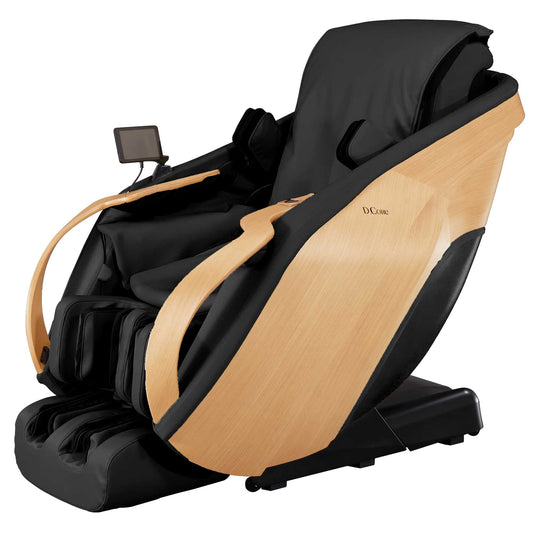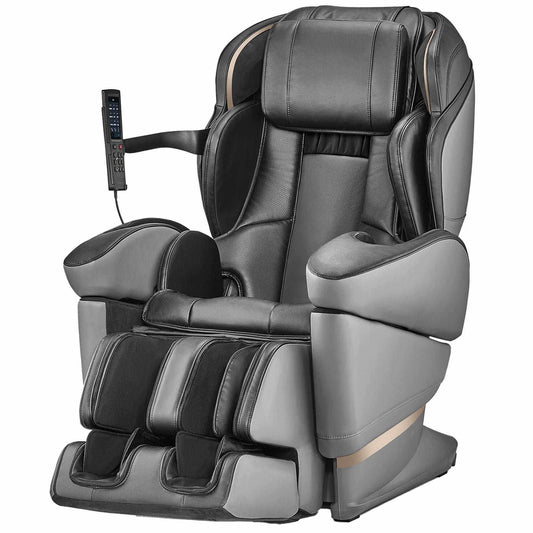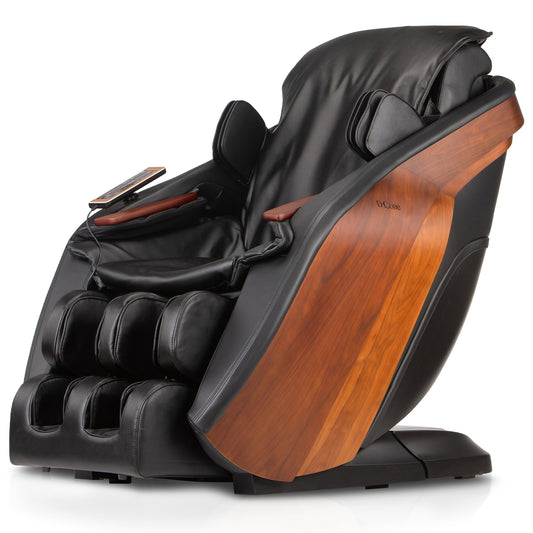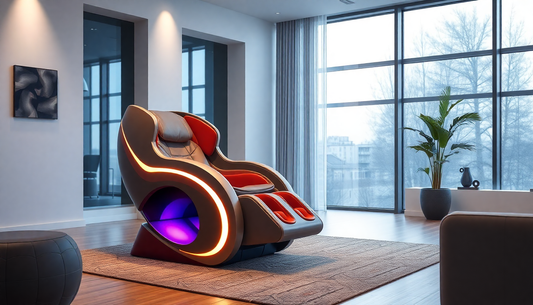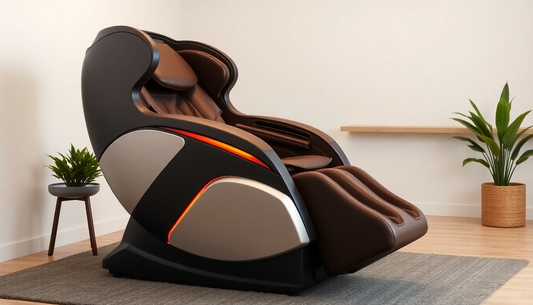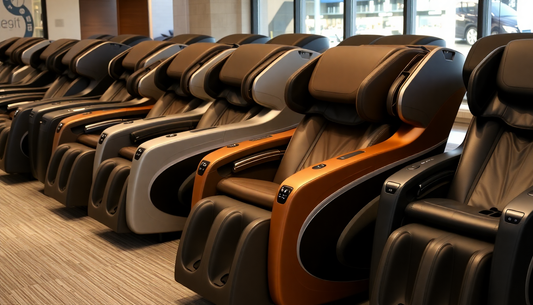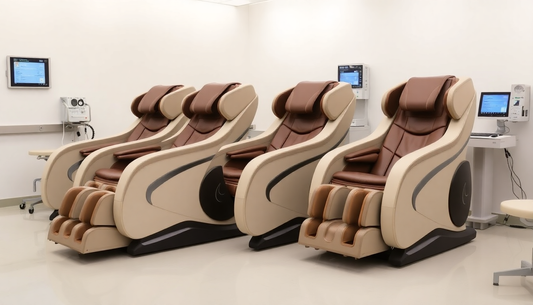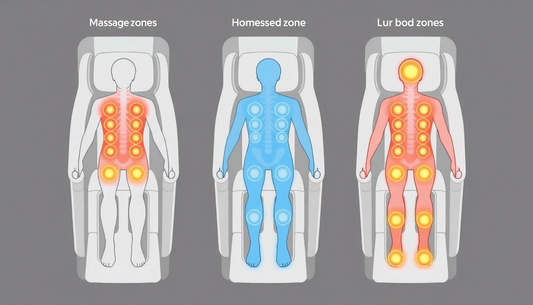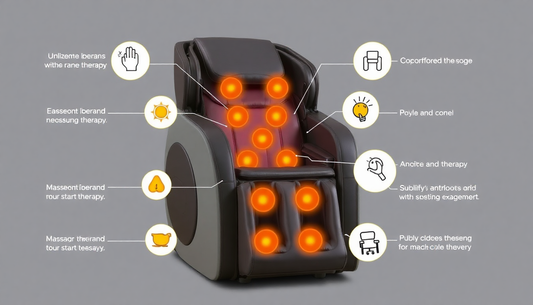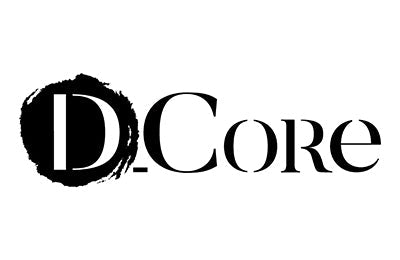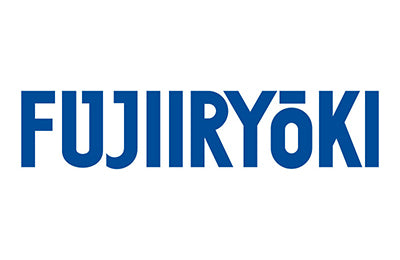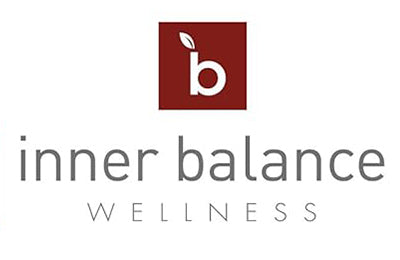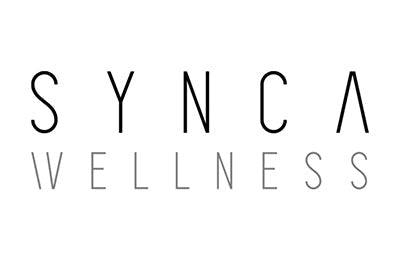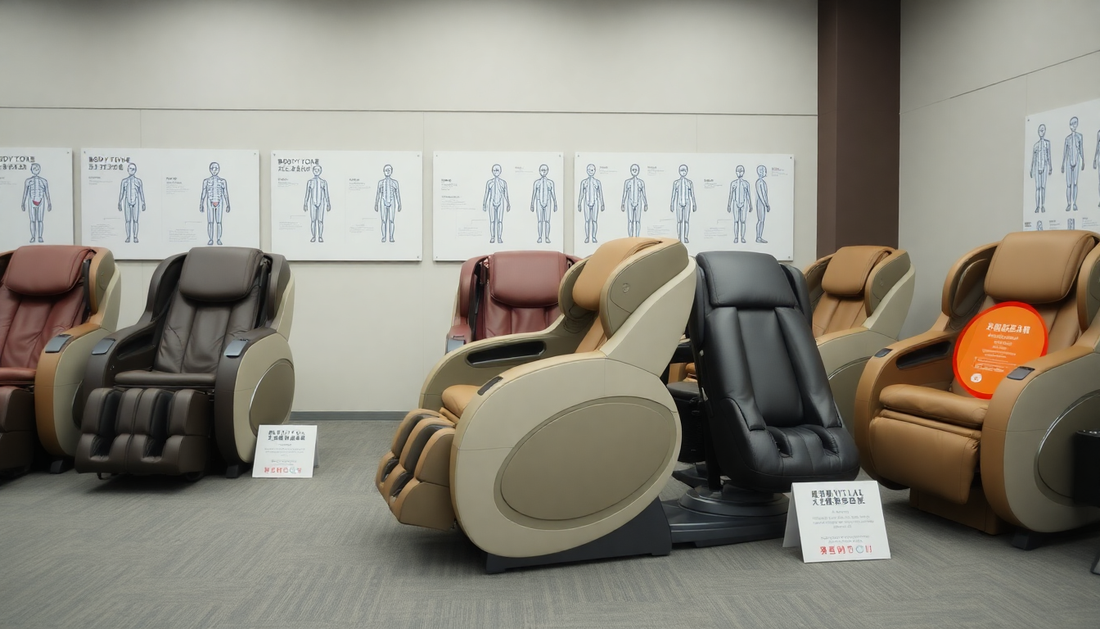
Mastering Fujiiryoki Massage Chairs: A Four-Day Presentation Guide (Calm Plus to Cyber Relax AI, Pro & Elite) — Massage Techniques, Target Zones & Therapeutic Benefits from Ankles to Head
Introduction: Purpose, Audience and Outcomes
This expanded four-day presentation guide is designed to be your complete resource for training staff, educating customers, and running engaging demonstrations of Fujiiryoki massage chairs: Calm Plus, Cyber Relax AI, Cyber Relax Pro, and Cyber Relax Elite. The guide assumes a presentation format with hands-on demos, scripted narration, safety guidance, and marketing tips so attendees leave with confidence to recommend each model for specific needs.
Who this guide is for
- Retail sales teams and product demonstrators
- Wellness center staff and spa managers
- Physiotherapists and rehab professionals who want to introduce massage chair options
- Corporate wellness coordinators and event presenters
- Enthusiasts and homeowners preparing buyer education events
What attendees will learn
- How each Fujiiryoki model differs and which user profiles match each model
- How massage techniques map to body parts from ankles to head
- How to run safe, persuasive live demonstrations and respond to common objections
- How to incorporate techniques and programs into therapeutic and recovery plans
Workshop overview and timeline
- Day 1: Calm Plus fundamentals and whole-body baseline routines
- Day 2: Cyber Relax AI personalization, AI mapping, and focused lower limb work
- Day 3: Cyber Relax Pro professional techniques, trigger point and deep tissue protocols
- Day 4: Cyber Relax Elite full-spectrum therapy, hybrid techniques, and family or clinical plans
Pre-workshop preparation
- Room and equipment checklist: power, lighting, quiet demonstration area, and spare linens or towels
- Technical verification: test each chair, firmware updates, remote or control panel operation
- Materials: printed handouts, program cheat sheets, safety consent forms, and feedback forms
- Volunteer or demo subject: recruit someone of average height and health for live demos or prepare recorded video alternatives
- Training plan: allocate time for questions, practical practice, and roleplay objection handling
SEO and presentation goals
- Primary keywords to use naturally: fujiiryoki massage chairs, calm plus, cyber relax ai, cyber relax pro, cyber relax elite
- Secondary long tail keywords: fujiiryoki reflexology, massage chair deep tissue, massage chair for chronic pain, ai body scan massage chair
- Suggested meta description: Comprehensive four-day training and demo plan for Fujiiryoki Massage Chairs from Calm Plus to Cyber Relax Elite, mapping techniques to body zones and therapeutic benefits
- Suggested URL slug: mastering-fujiiryoki-massage-chairs-four-day-presentation-guide
- On-page SEO tips: use h2 headings for each day, include image alt text describing specific zones and techniques, and embed video demonstrations where possible
Day 1 Calm Plus Core Techniques, Baseline Programs and Practical Sales Skills
Objective: Teach fundamental use, simple protocols, and sellability of Calm Plus as an approachable, reliable model for daily relaxation and light therapeutic support.
Model strengths to emphasize
- User-friendly interface and preset programs for quick demonstrations
- Comfort-forward cushioning and lumbar support suitable for general wellness
- Balanced technique selection ideal for new users and home settings
Expanded slide suggestions and content
- Slide 1: Calm Plus at a glance, target customers, and demo objectives
- Slide 2: Key preset programs and the typical session lengths for each
- Slide 3: Technique overview: Swedish, kneading, gentle shiatsu-style pressure
- Slide 4: Zone focus and mapping example with imagery of spine, shoulders, calves, and feet
- Slide 5: Demo script and audience takeaway with FAQs and safety notes
Minute-by-minute demo script for Calm Plus 20 minute sample
- 0-2 minutes: Introduction and posture check. Adjust recline to neutral spine and ensure feet are positioned in foot modules if used
- 2-6 minutes: Start a "Full Comfort" preset. Narrate Swedish long strokes over the upper back and shoulders and explain benefits related to circulation and stress reduction
- 6-12 minutes: Emphasize kneading on lumbar area and thighs. Explain how kneading can reduce muscle stiffness and help everyday mobility
- 12-16 minutes: Focus on foot and heel kneading or reflexology features. Describe expected sensations and safe intensity ranges
- 16-20 minutes: Wind down with lighter shoulder and neck strokes. Summarize immediate sensations, ask for subjective feedback, and record brief before/after notes
Mapping Calm Plus techniques to target zones and likely benefits
- Ankles and Heels: light reflexology and acupressure may support local circulation and reduce fatigue sensations
- Feet: gentle kneading and reflex-style routines can support plantar comfort after standing jobs
- Calves and Thighs: kneading and Swedish strokes to support muscle relaxation and mild flexibility gains
- Knees: gentle compression and acupressure for comfort; avoid aggressive trigger point work on inflamed joints
- Lower and Mid Back: kneading and softer deep tissue patterns for muscle therapy and posture awareness
- Shoulder and Neck: Swedish and gentle shiatsu for stress relief and reduced tension holding
- Head: gentle neck-focused strokes may improve relaxation and sleep onset when combined with breathing cues
Common customer objections and suggested responses
- Objection: I am worried about intensity. Response: Calm Plus is designed for gentle comfort and intensity can be adjusted; we recommend starting low and increasing gradually
- Objection: Will this help my back pain? Response: Many users report reduced muscle tension and improved mobility; it is complementary to clinical care, not a replacement
- Objection: Is it suitable for elderly users? Response: Yes for many, with reduced intensity and supervision; recommend a medical check if there are complex conditions
Day 1 exercise for trainees
- Practice delivering the 20 minute demo script with roleplay
- Collect before/after subjective ratings on comfort and tension using a short feedback form
- Record two minutes of demo video from different angles for review
Day 2 Cyber Relax AI Adaptive Personalization, Footwork and Targeted Recovery
Objective: Demonstrate how AI and adaptive mapping elevate personalization, especially for feet, ankles, heels, and calf recovery.
Key features and what they mean for the user
- AI body scan adapts roller paths and intensity to spinal curvature and posture
- Precision foot and heel modules for advanced reflexology and tissue therapy
- Custom user profiles to save preferred intensity, program order, and zone focus
Slide suggestions and narrative points
- Slide 1: How the AI scan works in plain language and what it optimizes
- Slide 2: Foot and ankle technology demonstration with visuals of reflex points
- Slide 3: Athlete and active user programs for recovery and performance support
- Slide 4: Senior user and low-impact recovery programs including recommended intensity limits
Deep demo script for Cyber Relax AI 25 minute sample
- 0-3 minutes: AI body scan and explanation of what the scan optimizes and why it matters for targeted therapy
- 3-8 minutes: Begin lower limb focused program: emphasis on calves, heels, and ankle reflex points; narrate sensation and likely short-term benefits
- 8-15 minutes: Shift to back and neck with adaptive roller paths; note how AI adjusts roller contact on uneven posture
- 15-20 minutes: Run a trigger point accent on shoulder and upper back while describing how AI can detect tension zones and adjust intensity
- 20-25 minutes: Conclude with a reflexology wind down and guidance on program frequency for recovery
Recommended user profiles and tailored settings
- Athlete after training: moderate to strong deep tissue on calves and thighs, foot reflexology at moderate intensity, cool down Swedish strokes for back
- Sedentary desk worker: focus on neck and shoulder trigger point settings with low to medium intensity and frequent short sessions
- Active older adult: low intensity foot reflexology and gentle Swedish strokes for spine and hips; avoid deep trigger point modes
Mapping Cyber Relax AI techniques to body parts with clinical caution
- Ankles: measured acupressure and reflexology to encourage local circulation; avoid if active swelling or known vascular issues
- Feet and Heels: reflexology, kneading; may reduce soreness and provide sensory relief after prolonged standing
- Calves and Legs: deep tissue and kneading for muscle therapy; advisable after exercise when muscles are warmed
- Lower and Mid Back: AI-optimized rollers for sustained contact and alignment support; use lower intensity for acute pain
- Neck and Shoulders: shiatsu and trigger point modes that the AI can temper for user comfort
Case study ideas for presentation (anecdotal, illustrative)
- Post-workout recovery plan for a weekend running club: 3 sessions per week focusing on calves and feet with AI personalization
- Desk worker relief plan: daily 10 minute neck and shoulder sequence over 4 weeks with subjective reports of reduced tension
Day 2 trainee exercise and custom program creation
- Create three saved profiles: athlete recovery, desk worker relief, and elderly mobility
- Run the AI scan on three different body types and note adjustments made by the chair
- Gather participant feedback on perceived changes in soreness or relaxation
Day 3 Cyber Relax Pro Therapeutic Depth, Trigger Point Protocols and Professional Use
Objective: Train teams to present the Pro model as the therapy-forward solution for customers with chronic tension or rehabilitation needs who seek deeper, more targeted work.
Pro model selling points
- Enhanced power and roller control for deeper tissue work
- Targeted trigger point routines and intensity customization
- Programs designed with therapeutic aims in mind such as spine alignment support and trigger release
Slide content and training outcomes
- Slide 1: Hardware differences vs Calm Plus and AI and why it matters for therapy
- Slide 2: Demonstration of trigger point routines and how to explain their purpose safely
- Slide 3: Protocol for chronic neck or low back tension including frequency guideline and progression
Demonstration script for professional protocols 30 minute sample
- 0-4 minutes: Intake questions and pre-checks including recent injuries, surgeries, or vascular concerns
- 4-10 minutes: Focused trigger point routine on upper trapezius and posterior neck with medium intensity and timed pauses
- 10-18 minutes: Deep lumbar and glute kneading combined with pelvic tilt-friendly positions to support spine mechanics
- 18-26 minutes: Thigh and hamstring deep tissue work for muscle balance and flexibility support
- 26-30 minutes: Gentle cooldown with Swedish strokes and breathing guidance to consolidate relaxation
Sample progressive therapy plan for chronic neck pain 4 week outline
- Week 1: Daily 10 minute low intensity neck and shoulder sessions to reduce acute tension and build tolerance
- Week 2: Alternate day 15 minute sessions adding trigger point focus for 1-2 targeted spots per session
- Week 3: 3 sessions per week at increased intensity with longer trigger point holds and combined thoracic rollers
- Week 4: Maintenance plan of 2-3 light sessions per week and reassessment with objective mobility tests
Clinical collaboration and responsibilities
- Recommend collaboration with a licensed clinician for customers with active injury or chronic disease
- Document client intake and any recommendations given during demos to reduce liability and provide continuity
- Advise clients to pause use and consult a clinician if they experience new or worsening symptoms
Day 4 Cyber Relax Elite Flagship Capabilities, Hybrid Techniques and Whole-Body Sequencing
Objective: Present Elite as the top-tier solution that integrates all techniques, supports head-to-toe coverage, and is suitable for families, home therapy, and premium corporate wellness.
Elite model highlights
- Comprehensive head, neck, shoulder, back, hip, leg and foot systems for full coverage
- Hybrid programs that combine Swedish, shiatsu, reflexology, trigger point and deep tissue in seamless sequences
- Precision modules for hands, wrists, ankles and heels for detailed care
Sample full-spectrum routine 35 minute flow
- 0-4 minutes: Gentle breathing and body scan intro while the chair calibrates
- 4-10 minutes: Feet and ankle reflexology to prime circulation and nervous system relaxation
- 10-16 minutes: Calves and thighs deep kneading for tissue warming and fatigue relief
- 16-24 minutes: Back and lumbar deep tissue with trigger point interspersed for muscle therapy and alignment support
- 24-29 minutes: Shoulder and neck targeted shiatsu and trigger release to reduce tension holding
- 29-33 minutes: Hand and wrist module activation for repetitive strain relief and sensory balance
- 33-35 minutes: Soothing Swedish wind down and post-session recommendations
Family, corporate and clinic use cases for Elite
- Family home: multiple user profiles and gentle-to-strong programs make Elite adaptable for different ages
- Corporate wellness: scheduled short sessions for staff to reduce workplace stress and encourage recovery
- Clinic adjunct: billing and intake collaboration with therapists for complementary recovery sessions
Mapping Massage Techniques to Target Zones Detailed Reference
Use this expanded mapping as a handout or slide for quick reference during demos and consultations.
Ankles and Heels
- Best techniques: reflexology, acupressure, light kneading
- Benefits: perceived improvement in local circulation, fatigue relief, and reduced foot heaviness
- Contraindications: avoid aggressive work with active swelling, open wounds, or diagnosed vascular disease
Feet
- Best techniques: reflexology, kneading, gentle compression
- Benefits: reduced plantar soreness, relaxation, improved sensory feedback
- Notes: emphasize gradual intensity increases for first time users
Calf and Thigh
- Best techniques: deep tissue, kneading, Swedish strokes
- Benefits: muscle therapy, fatigue relief, improved flexibility when paired with stretching
- Notes: ideal after exercise or at least 30 minutes after intense activity to reduce risk of soreness
Knee
- Best techniques: trigger point avoidance around inflamed joints, acupressure nearby, gentle compression
- Benefits: improved comfort and mobility when used cautiously; consult clinician if joint inflammation or instability present
Hands and Wrist
- Best techniques: kneading, acupressure, light compression
- Benefits: relief from repetitive strain sensations and improved dexterity comfort
Lower and Mid Back
- Best techniques: deep tissue, trigger point, kneading, spinal rolling
- Benefits: muscle therapy, possible spinal posture support, pain relief when used alongside clinical advice
- Notes: recommend lower intensities for acute flare ups and clinician contact for serious conditions
Shoulder and Neck
- Best techniques: trigger point release, shiatsu, Swedish strokes
- Benefits: stress relief, reduced tension, improved range of motion
- Notes: avoid high intensity directly over cervical spine without clinician approval
Head
- Best techniques: gentle shiatsu and neck-focused Swedish strokes
- Benefits: relaxation, improved sleep onset tendencies for many users
Whole Body
- Best techniques: blended programs combining Swedish, shiatsu, reflexology and kneading
- Benefits: comprehensive stress reduction, improved circulation, perceived tissue therapy
Massage Techniques Explained and When to Use Them
- Swedish Massage: long gliding strokes to enhance relaxation and blood flow control; good for warming tissue and reducing muscle tension
- Deep Tissue Massage: targeted pressure to deeper muscle layers for muscle therapy and injury recovery; use with caution for novice users
- Trigger Point Massage: focal pressure to relieve knot-like muscle areas; powerful when combined with stretching and clinician oversight
- Acupressure: sustained pressure on specific points to support relaxation and localized relief
- Shiatsu: rhythmic pressure and point work that can reduce tension and support spine alignment tendencies
- Reflexology: foot and hand point stimulation to support perceived systemic relaxation and local blood flow control
- Kneading: circular motions to release muscle stiffness and aid tissue hydration and flexibility
Safety, Contraindications and Responsible Communication
- Always ask about recent surgeries, fractures, deep vein thrombosis, pacemakers, pregnancy, and uncontrolled hypertension before demos
- Advise clients with medical conditions to consult their physician before beginning a new massage chair routine
- Avoid making absolute medical claims; use language like may help, can support, may reduce perceived symptoms, and consult a healthcare professional
- Recommend gradual increases in intensity for first-time users and those with chronic pain
Presentation Materials, Handouts and Slide Templates
- Quick cheat sheet: one page mapping techniques to body parts and suggested session lengths
- Intake questionnaire: short form to collect health flags and user goals
- Before/after feedback form: subjective scores for comfort, pain, mobility, and sleep quality
- Slide deck templates: model comparison slide, feature highlight slide, demo script slide, and Q and A slide
Marketing and SEO Enhancements for Your Content
- Use long form content and H2 headings for each model and each body zone to capture diverse search intents
- Create dedicated pages for each model and link them together using internal linking with descriptive anchor text such as Calm Plus demo and Cyber Relax AI personalization
- Include structured data using product and how-to schema on your website pages to improve visibility in search results
- Create video demos and transcribe them to add keyword rich content and increase time on page
- Suggested image alt text examples: fujiiryoki calm plus foot reflexology, cyber relax ai body scan in action, cyber relax pro trigger point demo
Sample FAQ to include on demo pages
- How often should I use a Fujiiryoki massage chair? Answer: Many users find daily short sessions of 10 to 15 minutes helpful. For deeper therapeutic plans, work with a clinician to personalize frequency.
- Can these chairs replace professional physical therapy? Answer: Massage chairs can complement therapy but are not replacements for clinician-prescribed rehabilitation.
- Are the chairs safe for seniors? Answer: Yes for many seniors when used at reduced intensity and with medical clearance if there are complex conditions.
Measuring success for training and sales
- Collect attendee confidence ratings before and after training
- Track conversion rates from demo visitors to buyers and record which demo scripts led to conversions
- Use feedback forms to iterate demo sequences and refine intensity guidance
Sample Post-Workshop Resources and Next Steps
- Deliverable pack: slide deck, one page cheat sheets per model, intake and feedback forms, and recommended follow up emails
- Suggested follow up email campaign: day 1 thank you, day 7 tips recap, day 30 check-in for program adherence
- Optional certification: create a short assessment and certificate for trainees to validate competency in running demos and safely advising clients
Appendix Presentation Scripts, Handout Templates and Sample Language
Include sample language for opening remarks, demo narration, safety disclosures, comparison language, and closing offers. Use consistent program names across models such as Recovery, Pain Relief, Sleep & Relax, Sports Reset to reduce confusion and strengthen brand recall.
Final Thoughts and Call to Action
This longer, comprehensive guide equips presenters with the knowledge, scripts and practical resources to confidently demonstrate Fujiiryoki massage chairs across customer types and use cases. The four-day structure makes training scalable and repeatable while the mapping of techniques to target zones helps attendees give tailored recommendations from ankles to head.
Ready to launch a four-day workshop series at your store or clinic? Start by printing the one page cheat sheets for each model, preparing the demo chairs, and scheduling a practice run. Collect live attendee feedback and iterate your scripts. If you want, export the sample materials in editable formats and adapt them to your brand voice.
